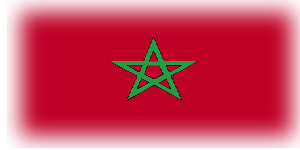

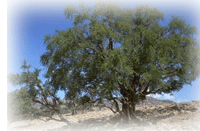
Argan Oil:
Implications as a Geographical Indication
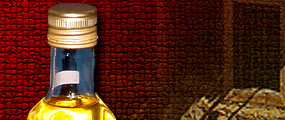 |
 |
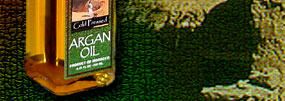 |
TED Case Studies
December 2004
by David Luth
Please send your comments to the author.
General Information Legal Cluster Bio-Geographic Cluster Trade Cluster Environment Cluster







1. The Issue
This case study explores the issue of classifying a product as unique as argan oil as a geographical indication (GI). There are several traits that separate argan oil from all other products. Argan oil has been marketed for the express purpose of economic development in the poor Berber region of Morocco. Does monopolization through designation as a GI help to develop that country? Is it a necessary step to take in order to protect that country from outside competition? As the argan tree happens to be targeted as a threatened species (the argan forest is listed under UNESCO's World Heritage endangered list), this study will also examine the effectiveness a GI classification would have in protecting this tree from extinction. In addition, unlike other GI’s, when the argument is more centered over the name of a product (such as feta cheese) and not the product itself, identifying the word “argan” as a GI would have significant consequences in that people producing similar products outside Morocco may not be able to use the word “argan” to describe their oil, even though it would be coming from the argan tree (Argania spinosa). To make a comparison, what would one do if he/she produced oil from an olive but was not allowed to call it “olive” oil? Will the consequences of classifying the argan tree as a GI reach this far? These are some of the questions this study hopes to touch on.
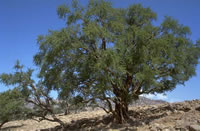
2. Description
What is Argan Oil?
The history of the Berbers, the name of the people who populate the Agadir region of Morocco, is intertwined with that of the argan; they have used it for hundreds of years as a source of food, charcoal, firewood, and building material. The argan’s oil, however, is probably its most notable use. In a addition to being used as a tradition medicine, argan oil is a staple in the Berber diet, usually eaten on bread or in amul, a sweet oil and almond paste used like peanut butter. The local population obtains as much as 25% of their daily lipid intake from the argan tree. It has been calculated that the people of the region spend a collective 20 million working days per year extracting the oil in addition to 800,000 working days collecting its firewood. (1)
The tree produces an oval-shaped green fruit which contains 2-3 kernels inside a pit. In order to extract the kernels from the almond, the almond must first be cracked open. This is the most difficult part of the process. The argan pit ranks among the hardest nuts in known. Machines designed to crack them have been know to fail. Once these are pounded open, however, the kernels inside are roasted lightly to bring out the flavor. The oil is then pounded out of them. Mixing the resulting paste with water brings the oil to the surface where it is then collected for use. (2) It takes 15-20 hours to produce the 5 1/2 lbs. (2 1/2 kilos) of kernels it is needed to produce one liter of argan oil. (3)
Argan oil’s healthful properties and myriad of uses have helped propel this product to stardom. It contains many antioxidants and is rich in vitamin E. These properties alone make argan oil an ideal ingredient for a variety of skin creams and other cosmetic products. It is even used to treat such ailments as arthritis and Poland has begun using it in the production of vitamin gel tablets. Most importantly,however, the rich aroma and nutty flavor of argan oil make it an exotic ingredient in the kitchens of gourmet chefs around the world. (4) Though the Berber people of southwestern Morocco have used it for centuries in their cuisine and for medicinal and cosmetic purposes, it has only been within the last decade that argan oil has become know to the outside world.
Recipes
Argan oil is used to makes many different foods. Amlou is the most common. This is a spread eaten on bread made of almonds and argan oil. The nutty taste of the oil is also very good when used on salads or used in sauces. (4) The closest product to argan oil would be a nut-derived oil such as almond oil or walnut oil. However, the argan nut is unique in and of itself and therefore cannot be fully replaced by any other product. Recipes
The
Issue of Geographical Indications
According to the Organization for an International Geographical Indications Network (ORIGIN) geographical indications are "...signs used on goods that have a specific geographical origin and possess qualities or a reputation that are due to that place of origin... Geographical indications are distinct from indications of source, which are nothing more than signs that specify that a product originated in a specific geographical region... Whereas trademarks put emphasis on the producer or manufacturer of a product, a geographical indication highlights the geographical region of origin of a good and the characteristics which are derived there from." (5) The European Union (EU) is seen as the pioneer of GIs since it is the primary region insisting that they be recognized.
Supporters list argan oil as a potential geographic indication. GIs can be useful in boosting the economies of lesser developed countries (LDC). By allowing an LDC to monopolize on a certain product, competition from other producers is eliminated. This allows the industry to grow unhindered, creating jobs directly inside the country.
There are difficult questions that must be answered before such a designation is given, however. Other geographic indicators
have gone to products which can be renamed, such as cheese and liquor. When
referring to argan oil, however, argan is used to describe the plant
it comes from, which just happens to be named after the region it comes from, Agadir.
A GI indication in this case would monopolize not just the name, the
entire product itself. One can compare it to producing oil that comes from an olive, but not being able to call it olive oil. The question deals with the fairness of such a designation. Due
to its production only in Morocco, there 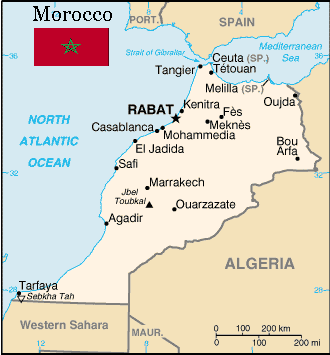 is a very limited supply of the oil.*
Should billions of consumers around the world be denied access to this wonderful
oil simply to keep its production is limited to one tiny part of the globe?
is a very limited supply of the oil.*
Should billions of consumers around the world be denied access to this wonderful
oil simply to keep its production is limited to one tiny part of the globe?
It is conceivable that some of the foods or products that are made using argan oil could in and of themselves be designated as geographic indications, such as the amlou. However, this is impractical for several reasons. First, it is easier to simply designate argan oil as a GI because it would then automatically incorporate any products that are created from it. Second, the demand is for the oil, which is then used to make other products. The demand is not for the products in and of themselves. However, Morocco may find it easier for the international community to designate some of these products as GIs, instead of the argan itself. This would still allow for the use of argan oil, just not for all products. But again, the demand is more for the oil, not its products, therefore GI designation of any products would have little tangible benefit for Morocco.
* Israel is attempting to grow a viable crop of argan tree in order to distribute it to the 600,000 Moroccans currently living in that country. Israel claims success insofar as making the tree grow, but it is uncertain whether or not the trees have produced fruit yet. Nonetheless, one thing is for certain; it will take thousands of trees to make production of the oil lucrative as one tree only produces about one liter of oil. (4)
3. Related Cases
By Issue:
neemtree- Involves the rights to usage of the neem tree, a tree that has been used in India for thousands of years. The conflict is between the U.S. and India. This is a potential conflict with the argan tree.
enola-bean- Involves the monopolization of an agricultural product by one person or entity.
By region:
Senegal-groundnut- impact of the groundnut in Senegal
cocoa- effect of Ivory Coast’s dependence on primary products on the environment
ethcoff- importance of coffee to the well-being of Ethiopia
safrfood- involves food security in the Southern African Development Community
Botswana- affect of cattle ranching in Botswana on the environment
olive- another Moroccan case study: importance of olive exports in Morocco and negative impact on environment
By environment:
coffee- Effect of coffee on Costa Rica’s environment
mangrove- Protection of another endangered tree: the mangrove in Vietnam
charcoal- Deforestation is a major problem in the Democratic Republic of the Congo due to the need for charcoal.
By development:
coconut- Addresses the issue of Philippine exportation of nata de coco to Japan and a sudden drop in Japanese demand. Nata de coco is being used in the Philippines to pull some of its people out of poverty, similar to argan oil.
Other GI Cases: Geographic Indications and Interantional Trade (GIANT)
4.
Author and Date: David Luth, December 2004







II. Legal Clusters
5.
Discourse and Status:
Morocco has been
a member of the World Trade Organization (WTO) since its formation in 1995 and
is thus subject to the Agreement on Trade-Related Aspects of Intellectual Property
Rights (TRIPS), which entered into force in July of that year. Geographic indications
are accorded protection in the TRIPS Agreement. Article 22 defines a geographic
indication as “…indications which identify a good as originating
in the territory of a Member, or region or locality in that territory, where
a given quality, reputation, or other characteristic of the good is essential
attributable to its geographic origin.” Under the TRIPS Agreement, member
states must provide protection to those products that are identified as geographic
indications. This means that other products cannot purposely mislead consumers
into believing that the product originated from a region from which it did not.
Furthermore, member states must give challenging states the legal means to fight
the product that infringes on the geographic indication.
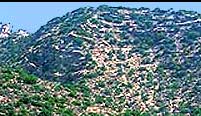 |
 |
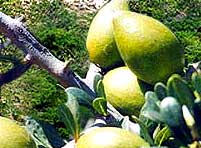 |
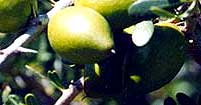 |
Argan oil has not been designated a geographic indication yet and the issue has not yet been dealt with by the WTO. The word “argan”, has, in fact, already been trademarked by a European country. (6) The WTO reports that Morocco has never been involved in any WTO trade disputes, neither as a complainant or respondent. (7)
US-Morocco Free Trade Agreement
One way Morocco could be able to ensure argan oil as a geographic indication would be if it were to demand that argan oil be recognized as such by the country it is making an agreement with. In this way argan oil will not be recognized by all countries, but at least by the ones to which it has made itself most vulnerable to imports. Morocco most recently signed a free trade agreement with the United States in June of 2004. In this agreement, the United States will eliminate all tariffs on agricultural products over a fifteen year period. A safeguard has been written into the agreement to allow the U.S. protection against low-priced horticultural products, however, this likely does not apply to argan oil, as it is a high-priced commodity. (8)
Morocco also has a
free trade agreement with EFTA, (the European Free Trade Association which includes
Iceland, Liechtenstein, Norway, and Switzerland). If Morocco would like to incorporate
geographic indications as a part of these trade agreements (presuming it has
not already done so with the United States) it is likely too late. The deal
would have to be renegotiated and then ratified again. Any country it makes
such a deal with would probably force Morocco to recognize its own geographic
indications, as Europe did with South Africa. Since argan oil is still a monopoly
in Morocco, and does not contribute significantly to overall GDP, it does not
seem that obtaining a geographic indication for argan oil would be a high priority
for the government of Morocco in the short term. However, it would protect Moroccan interests in the long term.
6. Forum and Scope: Morocco and unilateral
7. Decision Breadth:
8.
Legal Standing:







III. Geographic Clusters
9.
Geographic Locations
a. Geographic Domain:
Middle East
b. Geographic Site:
Middle East, Africa
c. Geographic Impact:
Morocco
10. Sub-National Factors: Yes, Agadir
11.
Type of Habitat: Dry







IV. Trade Clusters
12. Type of Measure: Import Ban
13. Direct v. Indirect Impacts: Direct
14.
Relation of Trade Measure to Environmental Impact
a. Directly Related
to Product: Yes, argan oil
b. Indirectly Related
to Product: No
c. Not Related to
Product: No
d. Related to Process: Yes, Intellectual Property
15.
Trade Product Identification: Argan Oil
Argan oil is exported
by only one country in the world, Morocco, as that is the only place it currently
grows. However, distributors in Europe and North America distribute the oil
around the globe to foreign markets in North America, Europe, and Asia. According
to one estimate global production of the argan fruit is approximately 350,000 tons, roughly 50 billion fruits. The Essaouira region alone is estimated to produce
approximately 1,000 to 2,000 tons of argan oil each year. It has been approximated
that between 60,000 and 120,000 trees live in that region and produce 142-286
million fruits each year. (1)
Hard trade data on argan oil is difficult to obtain, for several reasons. Argan oil is a
relatively new international product and the suppliers are rural Moroccans,
not large corporations who are able to keep records. The Targanine Oil Cooperative
had revenues of over $100.000 in 2000, with 60% of business being conducted
over the internet. (9) Most of these sales went to distributors in Europe and North
America. Since this data is four years old, it can only be assumed that exports
have increased along with the interest in the product.
It is estimated that 90% of the rural economy of the people of that region depends on the argan tree. This is due not only to the argan tree as a food source, but the other uses from which are derived from the tree: charcoal, building materials, food for livestock, shade, and soil stability for crops. (10)
16. Economic Data
Here is a sampling of several companies who sell argan oil over the World Wide Web. As one can see, bottle size differs somewhat, but the prices start at $19.75 and only get more expensive from there. One source claimed that prices are as high as $200.00 per liter, however, I was unable to find information supporting this claim. This explains why argan oil’s main foreign markets are in Europe, North America, and Asia. The poorer markets of Latin America and Africa are unable to pay such high prices for a luxury food.
Sampling of Argan Oil Internet Prices (11)
| COMPANY | AMOUNT | PRICE | AVG/ml |
| Earthy Delights | 8.45oz/ 250ml | $26.00 | 10.4¢ |
| Wild Wood Grove | 250ml | $35.42 |
14.16¢ |
| Argan3: | 200m/ 6.8 oz | $17.00 | 8.5¢ |
| 1 liter | $44.00 | 4.4¢ | |
| Exotica Oils: | 250ml | $19.75 | 7.9¢ |
| Gourmet Oil Company | 200ml | $39.00 | 19.5¢ |
17. Impact of Trade Restriction: Low
18. Industry Sector: Agriculture, cosmetics, pharmacological (vitamin gel tablets)
19.
Exporters and Importers: Morocco and many







V. Environment Clusters
20. Environmental Problem Type: Culture
Argania spinosa
The problem with
the argan tree is that it is a rare species
and if cultivated in the wrong manner oil production only exacerbates the peril
that it currently faces. Once a species that extended throughout North Africa,
the argan is now only found in the Agadir region of southwest Morocco. (2) The argan
forest there covers an area of approximately 700,000-800,000 hectares (320,000 square
miles), equaling 7% of the total forestland in all of Morocco. Argania spinosa is the only species of the Sapotaceae family that lives north of the Sahara
Desert, and is the only one to belong to the Argania genus. (1)
Factors Contributing to its Decline
The first factor is the very nature of
the argan itself and the climate it lives in. With a typical lifespan lasting
between 125-150 years, and some of the oldest specimens living more than double
this, the argan is a slow growth plant that takes its time maturing. The arid
climate which it inhabits encourages this slow maturation; the Agadir region
typically only receives between 200-300mm of rain per year. The argan is well
adapted to this harsh climate. It is an evergreen tree whose roots extend up
to 90 meters below the earth’s surface, making the argan essential in
preventing erosion, allowing for the replenishment of aquifers, and providing
a shield against desertification. In 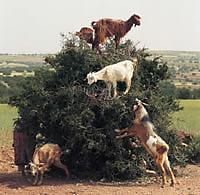 addition, the shade of the trees allows
for the growth of grasses that would otherwise wilt in the scorching sun. These
smaller plants also assist in the prevention of desertification, as well as
provide food for grazing animals. Despite these harsh conditions, the argan
is aptly suited for the climate and its is humans who are primarily to blame
for its decline.
addition, the shade of the trees allows
for the growth of grasses that would otherwise wilt in the scorching sun. These
smaller plants also assist in the prevention of desertification, as well as
provide food for grazing animals. Despite these harsh conditions, the argan
is aptly suited for the climate and its is humans who are primarily to blame
for its decline.
Humans use the tree for essential charcoal to feed their fires. In addition, they allow their livestock and goats, who like to climb the trees, to overgraze them. Humans have a tendency to over-harvest the fruit to make oil, which inhibits the tree from reproducing itself. It is estimated that the argan has lost a third of its coverage since the turn of the 19th century, and 600 hectares of argans are lost every year. Despite its reduction in numbers, however, the argan remains the life source of the people who populate the region.
Preservation Efforts
One woman who has revolved a great deal of her own life around the argan is Dr. Zoubida Charrouf. A chemist who specializes in organic chemistry, Dr. Charrouf has spent over fifteen years studying the makeup of the argan tree in an attempt to better understand its chemical properties and therefore its usefulness. In her research Dr. Charrouf discovered properties in the argan that exist nowhere else. These include an antioxidant and an anti-microbial agent. These might explain its healing properties and ability to get rid of foot fungus. Dr. Charrouf did all this research with the intent of marketing argan products for export, not for her own gain, but for the gain of those who depend upon it most.
Dr. Charrouf organized the first women’s argan cooperatives in Morocco. (12) Since women traditionally and exclusively make argan oil in Berber culture, no men belong to the cooperatives. These groups of women work together to produce argan oil and argan products, and ship them for export. Each woman belongs to the cooperative and is paid for the work that she does. All women are considered equal in the venture, and therefore are not the same as employees. (13)
The work that Dr. Charrouf has done has allowed the women to earn money to improve their lives and afford luxuries that were not available before, such as sending there children to school. The research that Dr. Charrouf has applied to the production of argan oil has also helped increase the livelihoods of these women. She used existing technology to pound the oil out of the argan kernels. Now it takes a machine two hours what used to take ten hours by hand. This allows the women much more free time to spend doing other things besides pounding argan nuts. (12) "My life has really changed. It used to be that I could never leave the house. Today, I am earning an income and can send my children to school," says one cooperative member. (14) In addition, Dr. Charrouf has taught her cooperatives how to best harvest the argan fruit and use the tree in the most friendly manners. This important education goes a long way in protecting the species from extinction.
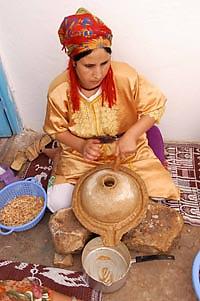 Should
the world community decide to make the argan a geographic indicator, this would
guarantee the women of Morocco a better life for an indefinite amount of time.
They will face no competition from foreign producers should they ever be successful
at cultivating the tree in other parts of the world. For the time being, the
women already have a natural monopoly, but what about future generations of
women? However, a geographic indicator would not simply reserve argan oil for
Moroccan production, it would prevent cultural pollution of a product that has
been produced exclusively by generations of Berber women for hundreds of years.
Argan oil is not simply a food commodity. It is a product that helps define
an entire ethnicity of people. Should people from outside the region begin marketing
the product it would be considered a hijacking of the Berber culture itself
for profit and gain. If anyone is to use the Berber culture to make money, advocates
argue, it rightly should only be the Berbers themselves, and the women who make
it possible.
Should
the world community decide to make the argan a geographic indicator, this would
guarantee the women of Morocco a better life for an indefinite amount of time.
They will face no competition from foreign producers should they ever be successful
at cultivating the tree in other parts of the world. For the time being, the
women already have a natural monopoly, but what about future generations of
women? However, a geographic indicator would not simply reserve argan oil for
Moroccan production, it would prevent cultural pollution of a product that has
been produced exclusively by generations of Berber women for hundreds of years.
Argan oil is not simply a food commodity. It is a product that helps define
an entire ethnicity of people. Should people from outside the region begin marketing
the product it would be considered a hijacking of the Berber culture itself
for profit and gain. If anyone is to use the Berber culture to make money, advocates
argue, it rightly should only be the Berbers themselves, and the women who make
it possible.
Other Preseravtion Efforts
The World Wildlife Fund is also working in Morocco to help save the argan forest. A plan for the sustainable use of products that come from the forest has been recently implemented. These products include argan oil, but also honey and handicrafts made from araar wood. Ecotourism is also be studied as a potential income earner. The World Wildlife Fund is also training beekeepers and producers of argan oil how to improve the quality of their products. When this is done, a process for certifying these products will be created in order to prove that the products were gathered in a way that is ecologically, socially and economically sound. This is similar to the certifications that guarantee that tuna was caught in a "dolphin safe" manner, or coffee was a bought at a "fair-trade" price from farmers in poor countries. This certifies that consumers realize the good forest management practices the producers are implementing. (15)
The Berber people inhabit modern day Morocco and Algeria where they make up 35-80% and 15-33% of the populations respectively. The Berber people and culture predate both Islam and the advent of Arabic. References to Berbers go back as far as time has been recorded. References are frequently made in ancient Egyptian, Greek and Roman sources. They are first meantioned by the Egyptians who fought against the Lebu (Lybians) in their western domains. The Berbers eventually expanded their territory, conquering the Egyptians in 945 BC, founding the Twenty-Sixth Dynasty. They also displaced black African tribes south of the Sahara. The Berbers were the main population of the western Sahara up until the Arab invasions during the sixth and seventh centuries. To this very day Berbers speak their own language and practice their own culture, which are distinct from the Arab language and culture. Argan oil represents an important part of this culture, around which revolves the life of the traditional Berber woman, as has been noted. (16)
21. Name, Type, and Diversity of Species
Name: Common: argan tree / Scientific: Argania spinosa
Type: Tree
Diversity: Grows only in Morocco
22. Resource Impact and Effect: High and Argan products: Many families' lives revolve around the argan tree. They use the tree for food, shelter, building materials, charcoal, firewood, and livestock feed. Loss of the tree would be devastating to these people. It would exacerbate the poverty in the region and create a mass migration to the cities. Life in the region would be unsustainable without the argan tree.
23. Urgency and Lifetime: High and Hundreds of years: The argan tree is disappearing at a rate of 600 hectares a year. Some scientists believe that the species has stopped re-germinating itself. As the climate is very dry, regermination is difficult, as water is usually the catalyst for germination.
24. Substitutes: Walnut oil, Almond oil, other nut-derived oils: Though it can be replaced in cuisine with other nutty-flavored oils, there is no real substitute for argan oil, it only comes from the Argania spinosa. Theoretically, if humans are the cause of desertification, they can reverse the trend by planting plants that stop desert encroachment. However, reclaiming land from the desert is very difficult. This can be done with other plants, however it is always best to use the native species. Another tree species in the region is the araar tree, but its numbers are also in decline for many of the same reasons as the argan. Araar is not used for oil, but its high-quality wood to make handicrafts for tourists, as well as for firewood, building materials, etc.







25. Culture: Yes: Berber, Moroccan
26. Trans-Boundary Issues: Yes
27. Rights: Yes, Berbers
28. Relevant Literature
1) Moussouris, Yorgos and Alan Pierce. Arid Lands Newsletter. “Biodiversity links to cultural identity in southwest Morocco : The situation, the problems and proposed solutions.”No. 48, November/December 2000. <http://ag.arizona.edu/OALS/ALN/aln48/moussouris&pierce.html> Accessed 5 September 2004.
2) Davenport, Philippa. “A hard nut to crack.” Financial Times. 29 March 2003. London. Sec: Food and Drink, pg. 15.
3) Morse, Kitty. "Ardent for Argan Oil." Saudi Aramco World. Vol. 5, No. 5. September/October 2004.
4) Ouhirra, Kimberly. Exotica Oils. < http://exoticaoils.com/comp.htm> Accessed 5 September 2004. Also: Personal phone conversation. 11 November 2004.
5) Organization for an International Geographical Indications Network. < http://www.origin-gi.com/> Accessed 23 October 2004.
6) The Newsletter 2: ORIGIN. "Two days to work out a common strategy," February 2004.
7) Morocco and the WTO. <http://www.wto.org/english/thewto_e/countries_e/morocco_e.htm>, Accessed 29 October 2004.
8) Office of the United States Trade Representative.“Free Trade with Morocco : A Vital Step Towards Middle East Reform.” <http://www.ustr.gov/Document_Library/Fact_Sheets/2004/Free_Trade_with_Morocco_A_Vital_Step _Towards_Middle_East_Reform.html >, Accessed 29 October 2004.
9) Lybbert, Travis, Christopher B. Barret, Hamid Narjisse. “Does Resource Commercialization Induce Local Conservation? A Cautionary Tale from Southwest Morocco.” Working paper. Cornell University, Ithaca, New York, 2003, pp. 13.
10) Lybbert, Travis, Christopher B. Barret, Hamid Narjisse. “Who Benefits from a Bio-Prospecting Based Boom? The Case of Argan Oil in Morocco.” Cornell University, Ithaca, New York, 2001.
11) Prices can be found at the corresponding websites: Earthy Delights: <http://earthy.com/> Wild Wood Grove: <www.wildwoodgroves.com> Argan3: <http://argan3.com/> Exotica Oils:<http://exoticaoils.com/> Gourmet Oil Company: <http://www.gourmetoil.com/>
12) Hibler, Michelle. “ Solving Pieces of the Argan Puzzle: Researcher Profile, Zoubida Charrouf.” The International Development Research Centre. < http://web.idrc.ca/en/ev-5483-201-1-DO_TOPIC.html> 2004. Accessed 20 September 2004
13) Abbono, Alessandra. Premio Slow Food. “Cooperative Amal.” <http://www.slowfood.com/img_sito/ premio/vincitori2001/pagine_en/marocco.html> Accessed 20 September 2004.
14) Rerhaye, Narjis. “ 'Amal' as in 'Hope': An Argan Oil Cooperative is Changing Women's Lives.” The International Development Research Centre. < http://web.idrc.ca/en/ev-5416-201-1-DO_TOPIC.html> 2004. Accessed 20 September 2004 .
15) "Morocco's argan and thuya woodlands." Project Report. 10 December 2002. <http://www.panda.org/about_wwf/where_we_work/mediterranean/on_the_ground/news.cfm?uNewsID=11421> Accessed 20 September 2004.
16) "Berber." Wikipedia Online Enclyclopedia. <http://en.wikipedia.org/wiki/Main_Page>. Accessed 13 December 2004.
Images provided by the CIA Factbook and through kind permission of Ms. Kimberly Ouhirra and the World Wildlife Federation.